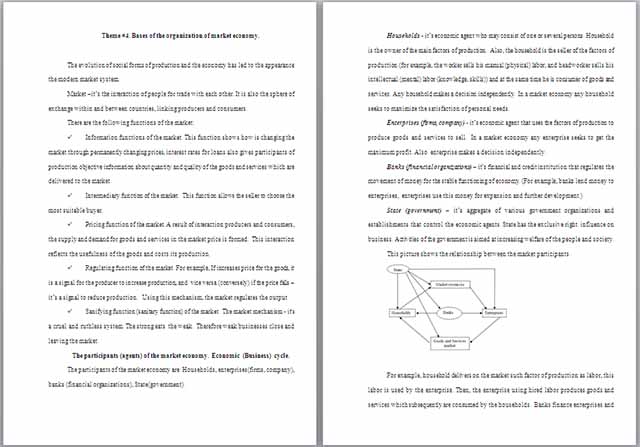The evolution of social forms of production and the economy has led to the appearance the modern market system.
Market –it’s the interaction of people for trade with each other. It is also the sphere of exchange within and between countries, linking producers and consumers.
There are the following functions of the market:
- Information functions of the market. This function shows how is changing the market through permanently changing prices, interest rates for loans also gives participants of production objective information about quantity and quality of the goods and services which are delivered to the market.

- Intermediary function of the market. This function allows the seller to choose the most suitable buyer.
- Pricing function of the market. A result of interaction producers and consumers, the supply and demand for goods and services in the market price is formed. This interaction reflects the usefulness of the goods and costs its production.
- Regulating function of the market. For example, If increases price for the goods, it is a signal for the producer to increase production, and vice versa (conversely) if the price falls – it’s a signal to reduce production. Using this mechanism, the market regulates the output.
- Sanifying function (Введите текст или адрес веб-сайта либо переведите документ.
- Отмена
- sanitarnaya funktsiya
- Возможно, вы имели в виду: санитарная функция
- Не удалось найти примеры употребления слова "Sanifying".
- автоматически переведено системой Google
- sanitary function) of the market. The market mechanism - it's a cruel and ruthless system. The strong eats the weak. Therefore weak businesses close and leaving the market.
The participants (agents) of the market economy. Economic (Business) cycle.
The participants of the market economy are: Households, enterprises(firms, company), banks (financial organizations), State(government).
Households - it’s economic agent who may consist of one or several persons. Household is the owner of the main factors of production. Also, the household is the seller of the factors of production (for example, the worker sells his manual (physical) labor, and headworker sells his intellectual (mental) labor (knowledge, skills)) and at the same time he is consumer of goods and services. Any household makes a decision independently. In a market economy any household seeks to maximize the satisfaction of personal needs.
Enterprises (firms, company) - it’s economic agent that uses the factors of production to produce goods and services to sell. In a market economy any enterprise seeks to get the maximum profit. Also enterprise makes a decision independently.
Banks (financial organizations) – it’s financial and credit institution that regulates the movement of money for the stable functioning of economy. (For example, banks lend money to enterprises, enterprises use this money for expansion and further development. )
State (government) – it’s aggregate of various government organizations and establishments that control the economic agents. State has the exclusive right influence on business. Activities of the government is aimed at increasing welfare of the people and society.
This picture shows the relationship between the market participants.
For example, household delivers on the market such factor of production as labor, this labor is used by the enterprise. Then, the enterprise using hired labor produces goods and services which subsequently are consumed by the households. Banks finance enterprises and households, and they use money for their own needs. Namely, the household to purchase goods and services, and enterprises to purchase raw materials, equipment, and to expand production. The state controls the all market participants and market relationships.
Полную информацию смотрите в файле.

 Получите свидетельство
Получите свидетельство Вход
Вход













 Конспект урока по английскому языку по теме "Bases of the organization of market economy" (22.4 КB)
Конспект урока по английскому языку по теме "Bases of the organization of market economy" (22.4 КB)
 0
0 261
261 7
7 Нравится
0
Нравится
0


